History of film technology

The history of film technology traces the development of film technology from the initial development of "moving pictures" at the end of 19th century to the present time. Motion pictures were initially exhibited as a fairground novelty and developed into one of the most important tools of communication and entertainment in the 20th century. Major developments in motion picture technology have included the adoption of synchronized motion picture sound, color motion picture film, and the adoption of digital film technologies to replace physical film stock at both ends of the production chain by digital image sensors and projectors.
Development of film technology
Precursors
The technology of film emerged mostly from developments and achievements in the fields of projection, lenses, photography and optics. Early techniques that involve motion and/or projection include:
- Shadowgraphy (probably in practice since prehistoric times)
- Camera obscura (a natural phenomenon that has possibly been used as an artistic aid since prehistoric times)
- Shadow puppetry (possibly originated around 200 BCE in Central Asia, India, Indonesia or China)
- Magic lantern (developed in the 1650s, preceded by some incidental and/or inferior projectors)
- stroboscopic "persistence of vision" animation devices (phénakisticope since 1832, zoetrope since 1866, flip book since 1868)
- Chronophotography (recorded with posed phases since the 1860s, recorded in real-time since 1878)
Live projection of moving images occur in the camera obscura, a natural phenomenon that may have been used artistically since prehistory. The use of a lens in a camera obscura has been dated back to 1550.[1] Mobile camera obscura devices were used since the early 17th century, first in tents and not much later in wooden boxes. The box-type camera would be adapted into a photographic camera in the 1820s and 1830s.
In or before 1659 the magic lantern was developed by Christiaan Huygens. It projected slides that were usually painted in color on glass. A 1659 sketch by Huygens indicates that moving images may have been part of the earliest screenings. Around 1790 multi-media phantasmagoria spectacles were developed. Rear projection, animated slides, multiple projectors (superimposition), mobile projectors (on tracks or handheld), projection on smoke, sounds, odors and even electric shocks were used to frighten audiences with a convincing ghost horror experience. In the 19th century several other popular magic lantern techniques were developed, including dissolving views and several types of mechanical slides that created dazzling abstract effects (chromatrope, et cetera) or that showed for instance falling snow or the planets and their moons revolving.
The basic stroboscopic principle that allowed the creation of motion pictures was discovered by Joseph Plateau in Belgium around December 1832 and published in January 1833. His invention - later known as the phénakisticope or fantascope - was a cardboard disc with slits through which the viewer could watch a rapid succession of sequential drawings (photography wasn't introduced yet) reflected in a mirror. If a phénakisticope disc spins fast enough it invisibly replaces each picture by the next one and the viewer sees figures in fluent motion. A very similar "Stroboscope Disc" was independently invented in Austria by Simon von Stampfer around the same time (probably some weeks later). Stampfer also mentioned several possible variations of his stroboscopic invention, including a cylinder (similar to the later zoetrope) as well as a long, looped strip of paper or canvas stretched around two parallel rollers (somewhat similar to film) and a theater-like frame (much like the later praxinoscope theatre).
In 1845, Francis Ronalds created an alternative technology – the first successful camera able to make continuous recordings of the varying indications of meteorological and geomagnetic instruments over time. The cameras were supplied to numerous observatories around the world and some remained in use until well into the 20th century.[2][3]
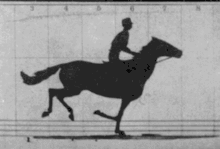
The first motion sequence photographed in real-time, rather than consisting of a series of posed photographs, was created in the US in 1878 by British photographer Eadweard Muybridge. Under the sponsorship of Leland Stanford, he photographed a horse named Sallie Gardner in rapid motion by using a series of separate still cameras. The experiment took place on June 15 at Stanford's stock farm in Palo Alto, California, with the press present, and was meant to determine whether a galloping horse ever had all four feet off the ground at the same time. The cameras were arranged in a line parallel to the edge of the track and spaced 27 inches apart. Each camera shutter was triggered by a thread as the horse passed and each exposure was made in only one thousandth of a second.[4] Originally the pictures were published as cards and plates. From 1879 to 1893 Muybridge also had silhouettes of his pictures painted onto glass discs to project the images onto a screen with a device he called a zoopraxiscope, which can be regarded as the first movie projector. His innovative process was an intermediate stage toward motion pictures and cinematography. Soon after the pictures were published, or at least since January 1879, there were several people who placed these in zoetropes to watch them in motion.[5] These were most likely the very first viewings of photographic motion pictures that were recorded in real-time.
Étienne-Jules Marey invented a chronophotographic gun in 1882, which was capable of taking 12 consecutive frames a second, recording all the frames on the same picture. He used the chronophotographic gun for studying animals and human locomotion.
An early projector, along similar lines to Muybridge's zoopraxiscope, was built by Ottomar Anschütz in 1887. His Electrotachyscope used 24 images on a rotating glass disk.[6] In 1894 his invention projected moving images[7] in Berlin.
First motion pictures
As a result of the work of Eadweard Muybridge and Étienne-Jules Marey, inventors in the late 19th century began to realize that the making and showing of photographic 'moving pictures' of a more useful or even indefinite length was a practical possibility.
The first motion picture camera was invented by the Frenchman Louis Le Prince in the 1880s, while working in Leeds, England. Le Prince had been inspired by Muybridge's pioneering experiments, and he patented his first invention, a 16-lensed camera, in 1887.[8] The first eight lenses would be triggered in rapid succession by an electromagnetic shutter on the sensitive film; the film would then be moved forward, allowing the other eight lenses to operate on the film. Although the camera was capable of 'capturing' motion, it was not a complete success because each lens photographed the subject from a slightly different viewpoint, with the result that foreground elements in the projected scene wove about relative to each other and to the background.
In May 1887,[8] after much trial and error, Le Prince was finally able to develop and patent the first single-lensed motion picture camera in 1888. He used it to shoot the world's earliest known motion picture on film: Roundhay Garden Scene, a short test photographed on October 14, 1888 in Roundhay, Leeds.[9]
Le Prince later used his camera to shoot trams and the horse-drawn and pedestrian traffic on Leeds Bridge (the movie was shot from Hicks the Ironmongers, now the British Waterways building, on the southeast side of the bridge;[10] a blue plaque now marks the spot). He initially shot his motion pictures on gelatin or glass plates but later switched to the more suitable celluloid, using film 1.75 inches wide.
In Leeds in 1889, Le Prince presented the first purely photographic motion picture projection, using equipment he designed. His single-lensed projector used an electric arc lamp to project the images onto a white screen.[11] He is regarded by many film historians as the father of motion pictures.[12]
| “ | "Le Prince had indeed succeeded making pictures move at least seven years before the Lumière brothers and Thomas Edison." Richard Howells (Screen vol.47 #2, p.179~200, Oxford University Press, 2006) | ” |
Development of film stock
Another early pioneer, working at roughly the same time as Le Prince, was William Friese-Greene. He began to experiment with the use of oiled paper as a medium for displaying motion pictures in 1885 and by 1887 he was experimenting with the use of celluloid. In 1889, Friese-Greene took out a patent for a 'chronophotographic' camera. This was capable of taking up to ten photographs per second using perforated celluloid film. A report on the camera was published in the British Photographic News on February 28, 1890.[13] He gave a public demonstration in 1890 of his device, but the low frame rate combined with the device's apparent unreliability made an unfavourable impression.
English anarchist and inventor Wordsworth Donisthorpe, filed for an early patent in 1876 for a film camera, which he named a "kinesigraph."[14] At the time, the necessary materials were not yet available to produce a working motion picture camera, but in 1889, his interest in the possibility was revived when he heard about the successful experiments of Louis Le Prince, who was then working in Donsithorpe's home town of Leeds. In 1889 he took out a patent, jointly with William Carr Crofts, for a camera using celluloid roll film and a projector system; they then made a short film of the bustling traffic in London's Trafalgar Square.[15][16][17]
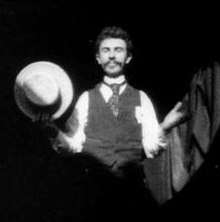
Another, more successful apparatus was invented by the Scottish inventor and employee of Thomas Alva Edison, W. K. L. Dickson. His camera, called the Kinetograph, was patented in 1891 and took a series of instantaneous photographs on standard Eastman Kodak photographic emulsion coated on to a transparent celluloid strip 35 mm wide. The celluloid blocks were thinly sliced, then removed with heated pressure plates. After this, they were coated with a photosensitive gelatin emulsion.
In 1893 at the Chicago World's Fair, Thomas Edison revealed the 'Kinetoscope' to the public. The machine was contained within a large box, and only permitted the images to be viewed by one person at a time looking into it through a peephole, after starting the machine by inserting a coin. The parlours were supplied with film snippets photographed by Dickson, in Edison's "Black Maria" studio. These sequences recorded both mundane incidents, such as Fred Ott's Sneeze, and entertainment acts, such as acrobats, music hall performers and boxing demonstrations. The Kinetoscope peep-show parlor first opened on April 14, 1894, and was the first commercial exhibition of film. Kinetoscope parlors soon spread successfully to Europe. Edison, however, never attempted to patent these instruments on the other side of the Atlantic, since they relied so greatly on previous experiments and innovations from Britain and Europe.
The Pleograph, invented by Polish emigre Kazimierz Prószyński in 1894[18] was another early camera. It also doubled up as a projector. The apparatus used a rectangle of celluloid with perforations between several parallel rows of images. Using an improved pleograph, Prószynski shot short films showing scenes of life in Warsaw, such as people skating in the park. Charles Francis Jenkins also exhibited his projector, the Phantoscope before an audience in June 1894.
Development of the film industry
Commercial cinema
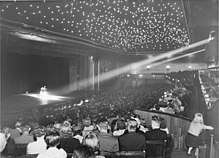
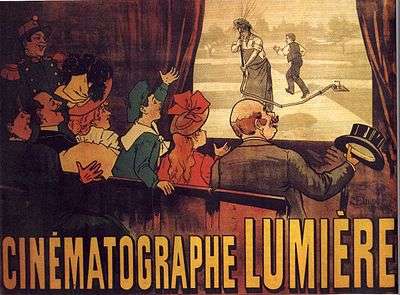
The Eidoloscope, devised by Eugene Augustin Lauste for the Latham family, was demonstrated for members of the press on April 21, 1895 and opened to the paying public on May 20, in a lower Broadway store with films of the Griffo-Barnett prize boxing fight, taken from Madison Square Garden's roof on May 4.[19] It was the first commercial projection.
In Lyon, Louis and Auguste Lumière perfected the Cinématographe, an apparatus that took, printed, and projected film. In late 1895 in Paris, father Antoine Lumière began exhibitions of projected films before the paying public, beginning the general conversion of the medium to projection. They quickly became Europe's main producers with their actualités like Workers Leaving the Lumière Factory and comic vignettes like The Sprinkler Sprinkled (both 1895). Even Edison, initially dismissive of projection, joined the trend with the Vitascope, a modified Jenkins' Phantoscope, within less than six months. [20]
A slightly earlier public motion-picture film presentation was made by Max and Emil Skladanowsky in Berlin, who projected with their apparatus "Bioscop", a flickerfree duplex construction, November 1 through 31, 1895. However, the equipment was cumbersome and its use was eventually discontinued.[21]
In Britain, Robert W. Paul and Birt Acres both independently developed their own systems for projecting a moving image on to a screen. Acres presented his in January 1896, and Paul unveiled his more influential Theatrograph shortly after on 20 February, on exactly the same day the Lumieres' films would first be projected in London.[22] The Theatrograph pioneered the ‘Maltese cross’ system that drove sprocket rollers to provide intermittent motion. After some demonstrations before scientific groups, he was asked to supply a projector and staff to the Alhambra Music Hall in Leicester Square, and he presented his first theatrical programme on 25 March 1896. His device was the prototype for the modern film projector and was sold across Europe.[23]
By 1896, it had dawned on the Edison company that more money could be made by showing motion picture films with a projector to a large audience than exhibiting them in peep-show machines. The Edison company took up a projector developed by Armat and Jenkins, the "Phantoscope", which was renamed the Vitascope, and it joined various projecting machines made by other people to show the 480 mm width films being made by the Edison company and others in France and the UK.
Initially, a lack of standardization meant that film producers used a variety of different film widths and projection speeds, but after a few years the 35-mm wide Edison film, and the 16-frames-per-second projection speed of the Lumière Cinématographe became the standard.[20]
Birt Acres designed the first camera for amateur use in 1898. He called it the 'Birtac Home Cinema', and it used a 17.5mm gauge. Its purpose, in his words, was 'to place animated photography in the reach of everyone'.[24]
Film industry

By the late 1890s, the first motion picture companies were established in the US, France, Britain and elsewhere.
The most successful motion picture company in the United States, with the largest production until 1900, was the American Mutoscope company. This was initially set up to exploit peep-show type films using designs made by W.K.L. Dickson after he left the Edison company in 1895.[25] His equipment used 70 mm wide film, and each frame was printed separately onto paper sheets for insertion into their viewing machine, called the Mutoscope. The image sheets stood out from the periphery of a rotating drum, and flipped into view in succession.[26][27]
Besides American Mutoscope, there were also numerous smaller producers in the United States, and some of them established a long-term presence in the new century. American Vitagraph, one of these minor producers, built studios in Brooklyn, and expanded its operations in 1905.

In France, the Lumière company sent cameramen all round the world from 1896 onwards to shoot films, which were exhibited locally by the cameramen, and then sent back to the company factory in Lyon to make prints for sale to whomever wanted them. There were nearly a thousand of these films made up to 1901, nearly all of them actualities.[28]
By 1898, Georges Méliès was the largest producer of fiction films in France, and from this point onwards his output was almost entirely films featuring trick effects, which were very successful in all markets. The special popularity of his longer films, which were several minutes long from 1899 onwards (while most other films were still only a minute long), led other makers to start producing longer films.[29]
In 1900, Charles Pathé began film production under the Pathé-Frères brand, with Ferdinand Zecca hired to actually make the films. By 1905, Pathé was the largest film company in the world, a position it retained until World War I. Léon Gaumont began film production in 1896, with his production supervised by Alice Guy.[30]
In the United Kingdom, Birt Acres was one of the first to produce films as well as being the first travelling newsreel reporter. In 1894 he created a 70 mm format and filmed the Henley Royal Regatta.[31] He went on to make some of Britain's first films with Robert W. Paul with a 35 mm movie camera, the Kineopticon, including Incident at Clovelly Cottage, The Oxford and Cambridge University Boat Race and Rough Sea at Dover.[32][33]
Charles Urban became managing director of the Warwick Trading Company in 1897, where he specialised in actuality film, including newsfilm of the Anglo-Boer War. In July 1903 he formed his own company, the Charles Urban Trading Company, moving to London's Wardour Street in 1908, the first film business to be located in what became the home of the British film industry.[34] Mitchell and Kenyon was founded by Sagar Mitchell and James Kenyon in 1897, soon becoming one of the largest film producers in the United Kingdom. Other early pioneers include James Williamson, G.A. Smith and Cecil Hepworth, who in 1899, began turning out 100 films a year, with his company becoming the largest on the British scene.
The Babelsberg Studio near Berlin in Germany was the first large-scale film studio in the world, founded 1912, and the forerunner to Hollywood with its several establishments of large studios in the early 20th century.
First cinemas
Initially, commercial screenings of motion-pictures for the public were put on in existing theatres and music halls as a novelty, but the main methods of exhibition quickly became either as an item on the programmes of variety theatres, or by traveling showmen in tent theatres, which they took around the fairs in country towns. It became the practice for the producing companies to sell prints outright to the exhibitors, at so much per foot, regardless of the subject. Typical prices initially were 15 cents a foot in the United States, and one shilling a foot in Britain. Hand-coloured films, which were being produced of the most popular subjects before 1900, cost 2 to 3 times as much per foot. There were a few producers, such as the American Mutoscope and Biograph Company, who did not sell their films, but exploited them solely with their own exhibition units.
The first public motion-picture film presentation in the world was done by Max and Emil Skladanowsky at the Berlin Wintergarten theatre, who projected with their apparatus "Bioscop", a flickerfree duplex construction, from November 1 through 31, 1895.
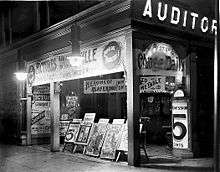
The first theatres dedicated to motion-pictures were established at the turn of the century, soon becoming known as cinemas. The Vitascope Hall in New Orleans was opened in 1896 as one of the first such establishments. It showed two exhibitions, one in the morning and one in the afternoon.
Another early establishment was the Islington Palace, originally built in 1869 as part of the Royal Agricultural Hall complex. The concert hall was converted into a full-time cinema in 1901, a year after it showed its first film.[35][36]
The Nickelodeon was the first successful permanent theatre showing only films, and opened in Pittsburgh in 1905. By then there were enough films several minutes long available to fill a programme running for at least half an hour, and which could be changed weekly when the local audience became bored with it. Other exhibitors quickly followed suit, and within a couple of years there were thousands of these "nickelodeons" in operation worldwide.
Color films
Additive process
.jpg)
The first person to demonstrate a natural-color motion picture system was British inventor Edward Raymond Turner, who applied for his patent in 1899, received it in 1900, and was able to show promising but very mechanically defective results in 1902.[37][38][39]
Turner's camera used a rotating disk of three color filters to photograph color separations on one roll of black-and-white film. A red, green or blue-filtered image was recorded on each successive frame of film. The finished film print was projected, three frames at a time, through the corresponding color filters.[40][41]:42
When Turner died in 1903, his financial backer at that time, pioneering film producer Charles Urban, passed on the development of the process to George Albert Smith, who by 1906 had developed a simplified version that he later named Kinemacolor. The Kinemacolor camera had red and green filters in the apertures of its rotating shutter, so that alternating red-filtered and green-filtered views of the subject were recorded on consecutive frames of the panchromatic black-and-white film. The Kinemacolor projector did the same thing in reverse, projecting the frames of the black-and-white print alternately through the red and green filters in its rotating shutter.
Both devices were operated at twice the usual frame rate to reduce the color flicker (technically known as "color bombardment") produced by non-simultaneous projection of the two color components, a defect which some viewers barely noticed but which others found obtrusive and headache-inducing. A related defect was the most obvious shortcoming of this process: because the two components had not been photographed at the same time, as pairs of frames, rapidly moving subjects did not adequately match up from one frame to the next when projected on the screen, resulting in color "fringes" or in extreme cases vividly colored "ghosts". A white dog wagging its tail in front of a dark background could appear to have several tails, variously red, green and white.[42]
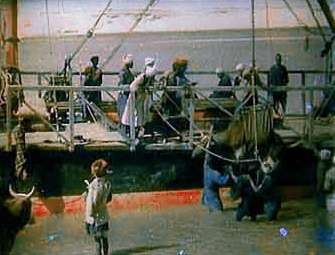
The first motion picture exhibited in Kinemacolor was an eight-minute short titled A Visit to the Seaside, which was trade-shown in September 1908. The general public first saw Kinemacolor in a program of 21 short films shown on 26 February 1909 at the Palace Theatre in London. The process was first seen in the US on 11 December 1909, at an exhibition staged by Smith and Urban at Madison Square Garden in New York.[43]
Kinemacolor released the first drama filmed in the process, Checkmated, in 1910, and the first feature-length documentary, With Our King and Queen Through India, in 1912.[44] Kinemacolor projectors were installed in some 300 cinemas in Britain, and 54 dramatic films were produced. Four dramatic short films were made in Kinemacolor in the US in 1912–1913,[45] and one in Japan in 1914. However, the company was not a success, partly due to the expense of installing the special Kinemacolor projectors.
A variant method was promoted by William Friese-Greene. He called his additive color system "Biocolour". It differed from Kinemacolor only in that the need for a filter-equipped projector was eliminated by staining alternate frames of the film itself with red and green dyes. An ordinary projector could therefore be used, if it would bear being cranked at a sufficient rate. Like Kinemacolor, Biocolour suffered from noticeable color flicker and from red and green fringing when the subject was in rapid motion.
In 1913, French film entrepreneur and inventor Léon Gaumont unveiled Chronochrome, a full-color additive system. The camera used three lenses with color filters to photograph red, green and blue color components simultaneously on consecutive frames of one strip of 35 mm black-and-white film. The projector had a corresponding triad of lenses. To reduce the strain imposed on the film as the mechanism in each device pulled it down three frames at a time, frame height was reduced from the usual four film perforations to three, resulting in a widescreen image format identical with the modern 16:9 aspect ratio.
Chronochrome's color quality was impressive, as surviving specimens attest,[46] and because the three frames were exposed and projected simultaneously, Kinemacolor's color bombardment and color fringes around moving objects were avoided. However, because the camera's three lenses could not all photograph the scene from exactly the same viewpoint, subjects that were too near the camera would exhibit color fringes if the registration of the three projected images was optimized for the background of the scene, and vice versa. A method of notching the prints to trigger automatic adjustment of the projection optics was invented, but expert supervision of the presentation was still a requisite. Light loss due to the color filters and the constrained dimensions of the projection lenses resulted in an image that was too dim for showing in a large auditorium unless a highly reflective metalized screen or rear-projection onto a translucent screen was used, and either solution created a "hot spot" that made the views from the side sections of the auditorium very unsatisfactory. The films were seldom screened outside of Gaumont's own cinemas and the system soon fell into disuse.
Technicolor
After experimenting from 1915 to 1921 with additive color systems that filmed and projected the two color components simultaneously, rather than in rapid alternation (thereby eliminating Kinemacolor's color flicker and false color fringes around rapidly moving objects), the Technicolor Motion Picture Corporation developed a subtractive color print process. As in its last additive system, the camera had only one lens but used a beam splitter that allowed red and green-filtered images to be photographed simultaneously on adjacent frames of a single strip of black-and-white 35 mm film, which ran through the camera at twice the normal rate. By skip-frame printing from the negative, two prints were made, on film stock with half the normal base thickness. They were chemically toned (i.e., the silver particles forming the black-and-white images were proportionally replaced by coloring matter) to colors roughly complementary to the filter colors (red for the green-filtered images and vice versa), as subtractive color reproduction requires.[47] They were then cemented together, base to base, into a single strip of film. No special projection equipment was needed.
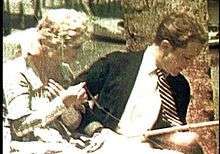
The first publicly shown film using this process was The Toll of the Sea (1922) starring Anna May Wong. Perhaps the most ambitious all-Technicolor feature was The Black Pirate (1926), starring and produced by Douglas Fairbanks.
In 1928, the system was refined by the adoption of dye imbibition, which allowed for the transferring of dyes from both color matrices into a single one-sided print, thus eliminating the complication of attaching two prints back to back and allowing multiple prints to be created from a single pair of matrices.[48]
Technicolor's system was popular for a number of years, but it was an expensive process: shooting cost three times as much as black-and-white photography and printing costs were also much higher. By 1932, color photography in general had nearly been abandoned by the major studios, but then Technicolor introduced a new process which recorded all three primary colors. Utilizing a dichroic beam splitter sandwiched between two 45-degree prisms in the form of a cube, light from the lens was split into two paths to expose three black-and-white films (two of them in bipack), one each to record the densities for red, green and blue.[49]
The three negatives were printed to gelatin matrix films, which were processed with a selectively hardening developer, treated to remove the silver, and hot-washed to leave only a gelatin relief of the images. A receiver print, consisting of a 50% density silver print of the black-and-white negative for the green component, and including the soundtrack and frame lines, was made and treated with dye mordants to aid in the imbibition process (the inclusion of a "black" image was discontinued in the early 1940s). The matrix for each color was soaked in its complementary dye (yellow, cyan, or magenta), then each in succession was brought into high-pressure contact with the receiver, which imbibed and held the dyes, thus reproducing a nearly complete spectrum of color, unlike previous two-color processes.[50] The first animation film to use the three-color (also called three-strip) system was Walt Disney's Flowers and Trees (1932), which introduced it to an enthusiastic public. The first short live-action film was La Cucaracha (1934), and the first all-color feature in "New Technicolor" was Becky Sharp (1935).[47]
The proliferation of television in the early 1950s contributed to a heavy mid-century push for color within the film industry. In 1947, only 12 percent of American films were made in color. By 1954, that number had risen to over 50 percent.[51] The color boom was aided by the breakup of Technicolor's near-monopoly on the medium. The last stand of black-and-white films made by or released through the major Hollywood studios came in the mid-1960s, after which the use of color film for all productions was effectively mandatory and exceptions were only rarely and grudgingly made.
Sound era

Initially, there were technical difficulties in synchronizing images with sound. However, there was still significant interest in motion pictures for films to be produced without sound. The era from the 1890s to the late 1920s, is commonly referred to as the silent era of film. To enhance the viewers' experience, silent films were commonly accompanied by live musicians and sometimes sound effects and even commentary spoken by the showman or projectionist. In most countries, intertitles came to be used to provide dialogue and narration for the film.
Experimentation with sound film technology, both for recording and playback, was virtually constant throughout the silent era, but the twin problems of accurate synchronization and sufficient amplification had been difficult to overcome (Eyman, 1997). In 1926, Hollywood studio Warner Bros. introduced the "Vitaphone" system, producing short films of live entertainment acts and public figures and adding recorded sound effects and orchestral scores to some of its major features.
During late 1927, Warners released The Jazz Singer, which was mostly silent but contained what is generally regarded as the first synchronized dialogue (and singing) in a feature film.[52] The early sound-on-disc processes such as Vitaphone were soon superseded by sound-on-film methods such as Fox Movietone, DeForest Phonofilm, and RCA Photophone. The trend convinced the largely reluctant industrialists that "talking pictures", or "talkies", were the future. A lot of attempts were made before the success of The Jazz Singer, that can be seen in the List of film sound systems.
Digital film
Digital cinematography, the process of capturing film images using digital image sensors rather than through film stock, has largely replaced analog film technology. As digital technology has improved in recent years, this practice has become dominant. Since the mid 2010s most of the movies across the world are captured as well as distributed digitally.[53][54][55]
Many vendors have brought products to market, including traditional film camera vendors like Arri and Panavision, as well as new vendors like RED, Blackmagic, Silicon Imaging, Vision Research and companies which have traditionally focused on consumer and broadcast video equipment, like Sony, GoPro, and Panasonic.
Current digital film cameras with 4k output are approximately equal to 35mm film in their resolution and dynamic range capacity, however, digital film still has a slightly different look to analog film. Some filmmakers and photographers still prefer to use analogue film to achieve the desired results.[56]
Digital cinema, the use of digital technology to distribute or project motion pictures has also largely replaced the historical use of reels of motion picture film, such as 35 mm film. Whereas traditional film reels had to be shipped to movie theaters, a digital movie can be distributed to cinemas in a number of ways: over the Internet or dedicated satellite links or by sending hard drives or optical discs such as Blu-ray discs. Digital movies are projected using a digital projector instead of a conventional film projector. Digital cinema is distinct from high-definition television and is not dependent on using television or high-definition video standards, aspect ratios, or frame rates. In digital cinema, resolutions are represented by the horizontal pixel count, usually 2K (2048×1080 or 2.2 megapixels) or 4K (4096×2160 or 8.8 megapixels). As digital cinema technology improved in the early 2010s, most of the theaters across the world converted to digital.[57]
See also
References
- ↑ Ilardi, Vincent (2007). Renaissance Vision from Spectacles to Telescopes.
- ↑ Ronalds, B.F. (2016). Sir Francis Ronalds: Father of the Electric Telegraph. London: Imperial College Press. ISBN 978-1-78326-917-4.
- ↑ Ronalds, B.F. (2016). "The Beginnings of Continuous Scientific Recording using Photography: Sir Francis Ronalds' Contribution". European Society for the History of Photography. Retrieved 2 June 2016.
- ↑ Clegg, Brian (2007). The Man Who Stopped Time. Joseph Henry Press. ISBN 978-0-309-10112-7.
- ↑ http://www.stephenherbert.co.uk/muybZOETROPES.htm
- ↑ Faszination der Bewegung: Ottomar Anschütz zwischen Photographie und Kino p. 185, Deac Rossell. ISBN 3-87877-774-4
- ↑ Industry, liberty, and a vision: Wordsworth Donisthorpe's kinesigraph, Stephen Herbert, p. 13, ISBN 0-9523941-3-8
- 1 2 Adventures in CyberSound: Le Prince, Louis Aimé Augustin, Dr Russell Naughton (using source: Michael Harvey, NMPFT Pioneers of Early Cinema: 1. Louis Aimé Augustin Le Prince)
- ↑ Brendan Bruce (2013). On the Origin of Spin: (Or how Hollywood, the Ad Men and the World Wide Web became the Fifth Estate and created our images of power). CreateSpace Independent Publishing Platform. p. 23.
- ↑ BBC Education – Local Heroes Le Prince Biography, BBC, archived on 1999-11-28
- ↑ E. Kilburn Scott (1974). Raymond Fielding, ed. A Technological History of Motion Pictures and Television. University of California Press. pp. 76–83.
- ↑ Rausch, Andrew (2004). Turning Points In Film History. Citadel Press. ISBN 978-0-8065-2592-1.
- ↑ Braun, Marta, (1992) Picturing Time: The Work of Etienne-Jules Marey (1830–1904), p. 190, Chicago: University of Chicago Press ISBN 0-226-07173-1; Robinson, David, (1997) From Peepshow to Palace: The Birth of American Film, p. 28, New York and Chichester, West Sussex, Columbia University Press, ISBN 0-231-10338-7)
- ↑ Burns, R. W. (1998). Television: An International History of the Formative Years. London: Institution of Engineering and Technology. ISBN 0-85296-914-7.
- ↑ "Wordsworth Donisthorpe: British inventor and political activist". Retrieved 2012-12-17.
- ↑ Burns, Paul T. "The History of The Discovery of Cinematography - 1885 - 1889". Retrieved 2009-05-10. and "Ten Remaining Frames Of Donisthorpe's 1890 'Trafalgar Square' Footage Come To Life" (GIF). Retrieved 2009-05-10.
- ↑ Herbert, S. (1998). Industry, Liberty, and a Vision: Wordsworth Donisthorpe's Kinesigraph. London: The Projection Box. ISBN 0-9523941-3-8.
- ↑ Maciej Ilowiecki, "Dzieje nauki polskiej", Wydawnictwo Interpress, Warszawa 1981, ISBN 8322318766, p.202 (Polish).
- ↑ Streible, Dan. Fight Pictures: A History of Boxing and Early Cinema. University of California Press. p. 46. ISBN 9780520940581. Retrieved 16 May 2016.
- 1 2 Microsoft® Encarta® Encyclopedia 2003. © 1993-2002 Microsoft Corporation.
- ↑ "The History of the Discovery of Cinematography".
- ↑ Mast, Gerald; Kawin, Bruce F. (2007). "Birth". In Costanzo, William. A Short History of the Movies (Abridged 9th ed.). Pearson Education, inc. pp. 23–24.
- ↑ "Theatrograph Projector No 2 Mark 1". Retrieved 2012-12-17.
- ↑ Wade, John (2004). Cine Cameras. Osprey Publishing. Retrieved 2013-02-07.
- ↑ Slide, Anthony (1998). The New Historical Dictionary of the American Film Industry. Lanham, Maryland: Scarecrow Press. ISBN 0-8108-3426-X.
- ↑ Billy Bitzer. "The Biograph Camera". The Operating Cameraman. Society of Camera Operators (Spring 1995). Archived from the original on 2004-11-01. Retrieved 2004-11-30.
- ↑ Musser, Charles (1994). The Emergence of Cinema: The American Screen to 1907. Berkeley, California: University of California Press. pp. 303–313. ISBN 0-520-08533-7.
- ↑ Gina De Angelis (2003). Motion Pictures. The Oliver Press. ISBN 978-1-881508-78-6.
- ↑ McLaren, Norman. Georges Melies : first wizard of cinema. Flicker Alley. 2008.
- ↑ Willems, Gilles "Les origines de Pathé-Natan" In Une Histoire Économique du Cinéma Français (1895–1995), Regards Croisés Franco-Américains, Pierre-Jean Benghozi and Christian Delage, eds. Paris: Harmattan, Collection Champs Visuels, 1997. English translation: The origins of Pathé-Natan Archived 2008-01-09 at the Wayback Machine. La Trobe University
- ↑ "Acres, Birt (1854-1918)". BFI Sceen Online. Retrieved 24 February 2013.
- ↑ Burns, Paul (1999). "Chapter 15, 1895-1900". The History of the Discovery of Cinematography. Archived from the original on 24 July 2011. Retrieved 2011-08-14.
- ↑ Birt Acres biography Archived 2011-07-12 at the Wayback Machine. accessed 21 June 2007
- ↑ https://www.flickr.com/photos/78112161@N00/7223737470/
- ↑ Penguin Pocket On This Day. Penguin Reference Library. 2006. ISBN 0-14-102715-0.
- ↑ James Chapman (2004). Cinemas of the World: Film and Society from 1895 to the Present. Reaktion Books. p. .
- ↑ http://nationalmediamuseumblog.wordpress.com/2012/09/12/edward-raymond-turner-discovery-re-writes-history-of-early-film/
- ↑ British Patent (B.P.) no. 6,202 (1899), 22 March 1899, 'Means for taking and exhibiting cinematographic pictures'. http://www.brianpritchard.com/GB189906202A.pdf
- ↑ http://www.nationalmediamuseum.org.uk/~/media/Files/NMeM/PDF/PlanAVisit/LeeTurnerTimeline.pdf
- ↑ Pritchard, B. (2012). "Lee-Turner Project with the National Media Museum". Retrieved 20 April 2013.
- ↑ Robert Allen Nowotny (1979). The Way of All Flesh Tones. University of Texas at Austin. ISBN 978-0-8240-5109-9. Retrieved 2012-09-13.
- ↑ Widescreen Museum
- ↑ http://bioscopic.wordpress.com/2008/06/15/colourful-stories-no-11-kinemacolor-in-america
- ↑ Salvage Operations of S.S. Oceana Produced by the Natural Colour Kinematograph Co., Brighton on IMDb
- ↑ La Tosca (1912), Mission Bells (1913), The Rivals (1913), and The Scarlet Letter (1913).
- ↑ Gaumont Chronochrome at the WideScreen Museum. Retrieved 24 June 2016.
- 1 2 Ephraim Katz, The Film Encyclopedia (HarperCollins, 1994) ISBN 0-06-273089-4
- ↑ Ira Konigsberg, The Complete Film Dictionary Meridan PAL Books, 1987) ISBN 0-452-00980-4
- ↑ Slide, Anthony. (1990) "Technicolor" The American Film Industry: A Historical Dictionary Limelight pp. 338-340. ISBN 0-87910-139-3
- ↑ Hart, Martin (2003). "The History of Technicolor" Widescreenmuseum.com. Retrieved 2006-07-07.
- ↑ David A. Cook, A History of Narrative Film (2nd edition, W. W. Norton & Company, 1990). ISBN 0-393-95553-2
- ↑ Note: It has been claimed that this was actually accomplished first by Charles Taze Russell in 1914 with the lengthy film The Photo-Drama of Creation, which consisted of projected slides and moving pictures synchronized with phonograph records of talks and music. There is apparently no evidence that the synchronization was anything more than loose and approximate — adequate for providing musical accompaniment or narration appropriate to the scene being shown on the screen, but not lip-synchronous on-screen speech or singing — or that any simultaneous filming and sound recording was involved.
- ↑ "Qube Cinema Supports Cinecolor in Its Transition to Digital Cinema in Latin America". qubecinema.com.
- ↑ "How Digital Conversion Is Killing Independent Movie Theaters". Rolling Stone.
- ↑ Michael Hurley (2 January 2014). "Studios Abandon Film, Small Theaters Struggle -- And There's a happy ending - Indiewire". Indiewire. Archived from the original on 2016-02-01.
- ↑ "Film vs. Digital: A Comparison of the Advantages and Disadvantages". PetaPixel. 26 May 2015. Retrieved 2016-06-28.
- ↑ Leo Barraclough (June 23, 2013). "Digital Cinema Conversion Nears End Game". Variety.
https://www.todayhinditech.com/android-kya-hai-android-ki-puri-jaankari-hindi-me/
Further reading
- Munslow., Alun (December 2007). "Film and history: Robert A. Rosenstone and History on Film/Film on History". Rethinking History. 4 (11): 565–575.
- Abel, Richard. The Cine Goes to Town: French Cinema 1896-1914University of California Press, 1998.
- Acker, Ally. Reel Women: Pioneers of the Cinema, 1896 to the Present. London: B.T. Batsford, 1991.
- Barnes, John. The Cinema in England: 1894-1901 (5 Volumes) University of Exeter Press, 1997.
- Basten, Fred E. Glorious Technicolor: The Movies' Magic Rainbow. AS Barnes & Company, 1980.
- Bowser, Eileen. The Transformation of Cinema 1907-1915 (History of the American Cinema, Vol. 2) Charles Scribner's Sons, 1990.
- Rawlence, Christopher (1990). The Missing Reel: The Untold Story of the Lost Inventor of Moving Pictures. Charles Atheneum. ISBN 978-0689120688.
- Cousins, Mark. The Story of Film: A Worldwide History, New York: Thunder's Mouth press, 2006.
- Dixon, Wheeler Winston and Gwendolyn Audrey Foster. A Short History of Film, 2nd edition. New Brunswick: Rutgers University Press, 2013.
- King, Geoff. New Hollywood Cinema: An Introduction. New York: Columbia University Press, 2002.
- Merritt, Greg. Celluloid Mavericks: A History of American Independent Film. Thunder's Mouth Press, 2001.
- Musser, Charles (1990). The Emergence of Cinema: The American Screen to 1907. New York: Charles Scribner's Sons. ISBN 0-684-18413-3.
- Nowell-Smith, Geoffrey, ed. The Oxford History of World Cinema. Oxford University Press, 1999.
- Parkinson, David. History of Film. New York: Thames & Hudson, 1995. ISBN 0-500-20277-X
- Rocchio, Vincent F. Reel Racism. Confronting Hollywood's Construction of Afro-American Culture. Westview Press, 2000.
- Salt, Barry. Film Style and Technology: History and Analysis 2nd Ed. Starword, 1992.
- Salt, Barry. Moving Into Pictures Starword, 2001.
- Usai, P.C. & Codelli, L. (editors) Before Caligari: German Cinema, 1895-1920 Edizioni Biblioteca dell'Immagine, 1990.
External links
| Wikimedia Commons has media related to History of cinema. |
- View inside an ancient film camera *popup warning, possible vanity site*
- Museum Of Motion Picture History, Inc.
- History exhibit of filmmaking in Florida, presented by the State Archives of Florida
- American Cinematographer - January, 1930, THE EARLY HISTORY OF WIDE FILMS
- History of Film Formats
- Technicolor History
- What is a Camera Obscura?
- Film Sound History at FilmSound.org
- An Introduction to Early cinema
- List of Early Sound Films 1894-1929 at Silent Era website
- Official Web Site of Film Historian/Oral Historian Scott Feinberg
- Reality Film
- Film History by Decade *popup warning*
- Project "Westphalian History in the film"
- Cinema: From 1890 To Now